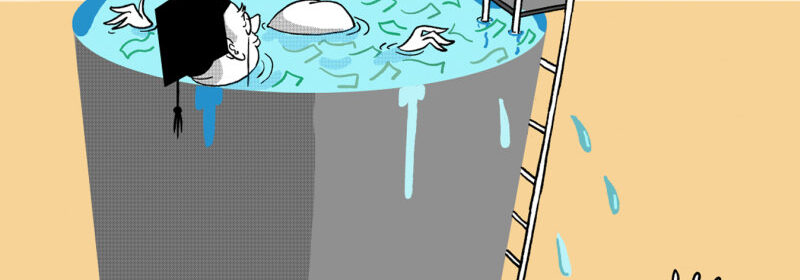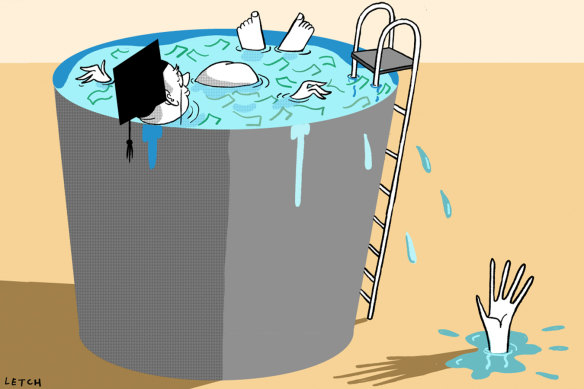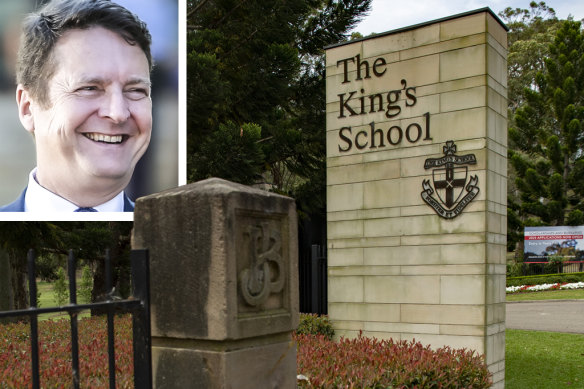How identity politics has plunged our public schools into crisis

Save articles for later
Add articles to your saved list and come back to them any time.
When one of the most privileged and oldest private schools in Australia, The King’s School – home to the scions of the squattocracy – has to be ordered by the NSW government not to spend public money on a plunge pool at its headmaster’s residence, that’s when you know there’s something very wrong with the way federal and state governments are dividing their funding between public and private schools.
It’s a system where the less government help a school needs, the more it’s given, and the more a school needs the more likely it won’t be given enough.
Illustration by Simon Letch.Credit:
Although the famous Gonski report of 2011 recommended that government funding of schools be based on the assessed needs of their mix of students, more than a decade later that hasn’t happened.
Why not? Partly because, unlike most other English-speaking countries, Australia has allowed the mainstream Christian churches to play a big role in the provision of primary and secondary education.
They had schools before the government decided to introduce compulsory public schooling, and were allowed to keep running them. To this day, they’re allowed to provide religious instruction in public schools where – despite our growing lack of religiosity – the churches fight against ethics classes being offered as an alternative.
Led by the Catholics, the private schools fought to stop the Gonski reforms reducing their funding and control over how it was spent. Anachronistically, our politicians remain wary of getting off side with the church vote.
The Kings School decided against building a plunge pool at the residence of its headmaster Tony George after public uproar.Credit: Sydney Morning Herald Wolter Peeters
But the other reason for the backsliding on Gonski is the much earlier decision of the Howard government to make parents’ choice of school – not student need – the highest priority for government funding.
John Howard got the states to licence many new private schools, most of them with some religious affiliation. This has changed the nature of Australian schooling in a way few people have noticed.
Have you heard of “identity politics”? It’s the modern tendency for voters to think of themselves not just as Australians, or even Labor or Liberal, but as part of an ethnic, religious or gender-preference group.
There was a time when almost everyone was educated at the local public or parish school. At school, you learnt to get along with people from many different social classes and backgrounds. These days, only a small majority of students go to public schools, and it’s now common for Jewish kids to go to Jewish schools, Muslims to Muslim schools, evangelical Protestants to “Christian schools” and so forth.
Sorry, this may be what many parents choose for their offspring, but I’m not sure if it will be good for national tolerance and social cohesion. Just as bad, it’s happening at the expense of public schools, left with too few resources to do justice to the more than 80 per cent of disadvantaged students – those of the lowest socio-economic status, Indigenous and the outback (not to mention misbehaving kids expelled from private schools).
Private schools can – and do – say no to kids with problems, but public schools can’t.
According to official figures collated by Trevor Cobbold, of Save our [public] Schools, combined annual federal and state funding grew by more than $2800 per independent school student over the nine years to 2020, after allowing for inflation. That compares with increases of almost $2500 per Catholic school student and just $830 a year per public school student.
Across Australia this year, combined government funding is estimated to have provided private schools (Catholic plus independent) with 106 per cent of the Gonski-inspired, officially calculated “schooling resource standard” needed to meet the particular needs of their students. Public schools will get just 87 per cent of what they need.
Add huge tuition fees, and you see why long-established independent schools have far more income than they need just to run the school. Many have never-ending construction programs moving round and round the cramped school campus, tearing things down and building new indoor swimming centres, music and drama centres, auditoriums and sporting facilities.
Casual observation suggests that independent schools get better academic results than Catholic schools and, particularly, public schools. But many studies show that, once you allow for the socio-economic status of the students’ parents, independent and Catholic schools do no better than public schools.
If governments keep over-funding private schools and underfunding public schools, however, a lot more parents will feel they need to pay up, so they can move their kids to private, leaving public schools with a much higher proportion of disadvantaged students that they’re inadequately resourced to help.
Doesn’t sound like a road we should want to travel.
After coming to office last year, the Albanese government postponed any changes to federal funding of schools for a year, so an expert panel could report on the National Schools Reform Agreement, the agreement between the feds and states on school funding.
The panel’s report is due this month. But even if it recommends big reforms, you wouldn’t be sure this bruised and battered government would be up for the fight with privileged schools and their parents.
Ross Gittins is economics editor.
Ross Gittins unpacks the economy in an exclusive subscriber-only newsletter. Sign up to receive it every Tuesday evening.
Most Viewed in Business
From our partners
Source: Read Full Article


